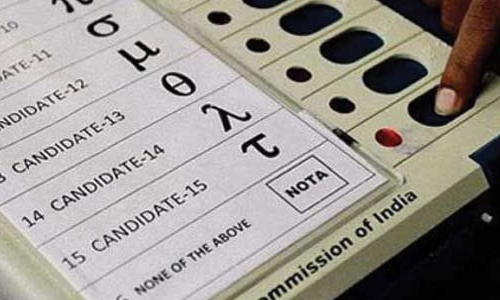Live
- Rajasthan CM casts his vote, says BJP will repeat history
- Ex-MP CM Kamal Nath, son Nakul Nath cast votes in Chhindwara
- Hyderabad: HC directs police to permit Hanuman Vijaya Yatra rally with 100 bikes on April 23
- LS polls: PM Modi to campaign in UP, MP and Maharashtra today
- ‘Narmada Pushkara Kshetra Darsini’ book released
- Gold rates in Delhi slashes, check the rates on 19 April 2024
- Gold rates in Visakhapatnam slashes, check the rates on 19 April 2024
- Filing of nomination commences
- Gold rates in Vijayawada slashes, check the rates on 19 April 2024
- Gold rates in Hyderabad slashes, check the rates on 19 April 2024
Just In

None Of The Above’, or NOTA for short, also known as ‘against all’ or a ‘scratch’ vote, is a ballot option in some jurisdictions or organizations, designed to allow the voter to indicate disapproval of all of the candidates in a voting system. It is based on the principle that consent requires the ability to withhold consent in an election, just as they can by voting ‘No’ on ballot questions.
None Of The Above’, or NOTA for short, also known as ‘against all’ or a ‘scratch’ vote, is a ballot option in some jurisdictions or organizations, designed to allow the voter to indicate disapproval of all of the candidates in a voting system. It is based on the principle that consent requires the ability to withhold consent in an election, just as they can by voting ‘No’ on ballot questions.
Entities that include ‘None of the Above’ on ballots as standard procedure include India (‘None of the above’), Greece (white), the U.S. state of Nevada (None of These Candidates), Ukraine (‘against all’), Spain (voto en blanco, ‘white vote’), and Colombia (voto en blanco). Russia had such an option on its ballots (‘against all’) until it was abolished in 2006.
Bangladesh introduced this option in 2008.Pakistan introduced this option on ballot papers for the 2013 Pakistan elections, but the Election Commission of Pakistan later rejected it. Beginning with the 2016 presidential election, Bulgaria introduced a 'none of the above' option, which received 5.59% of the vote in the first round and 4.47% in the run-off.
When ‘None of the Above’ is listed on a ballot, there is the possibility of NOTA receiving a majority or plurality of the vote, and so ‘winning’ the election. In such a case, a variety of formal procedures may be invoked, including having the office remain vacant, having the office filled by appointment, re-opening nominations or holding another election (in a body operating under parliamentary procedure), or it may have no effect whatsoever, as in India and the US state of Nevada, where the next highest total wins regardless.
The Election Commission of India told the Supreme Court in 2009 that it wished to offer the voter a ‘none of the above’ option on ballots, which the government had generally opposed. The People's Union for Civil Liberties, a non-governmental organisation, filed a public-interest litigation statement in support of this.
On 27 September 2013, the Supreme Court of India ruled that the right to register a ‘none of the above’ vote in elections should apply, and ordered the Election Commission to provide such a button in the electronic voting machines, noting that it would increase participation.
The Election Commission also clarified that even though votes cast as NOTA are counted, they are considered as invalid votes so they will not change the outcome of the election process. They are not taken into account for calculating the total valid votes and will not be considered for determining the forfeiture of security deposit. In the 2014 general election, NOTA polled 1.1% of the votes, counting to over 6,000,000.
The specific symbol for NOTA, a ballot paper with a black cross across it, was introduced on 18 September 2015. The symbol is designed by National Institute of Design, Ahmedabad.

© 2024 Hyderabad Media House Limited/The Hans India. All rights reserved. Powered by hocalwire.com







